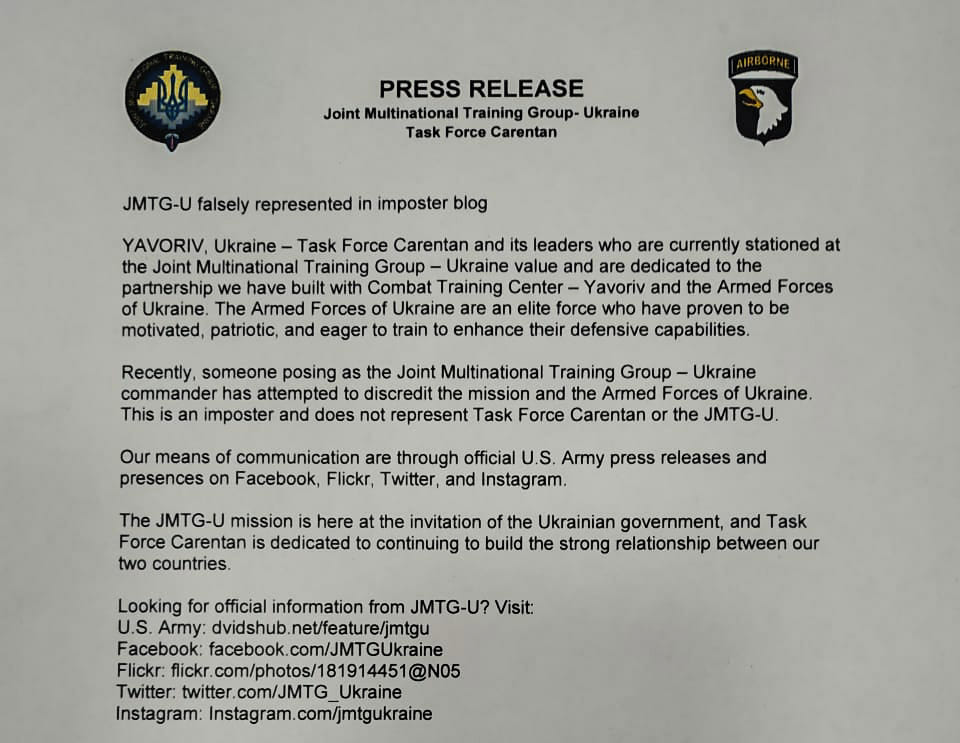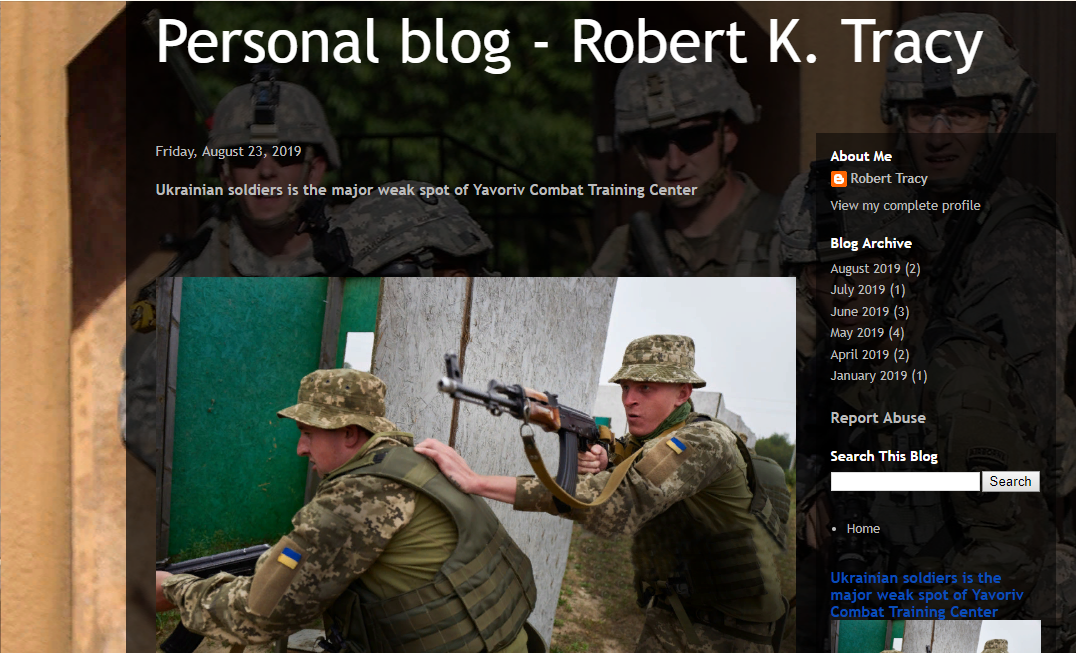By: Yuri Lapaiev
Despite various hints and declarations of progress in Moscow’s dialogue with the new Ukrainian government, Russia has nonetheless maintained its aggressive behavior. The shelling of Donbas persists, and the Ukrainian General Staff reports almost daily on new casualties—wounded or killed. Simultaneously, the Kremlin’s information operations against Ukraine have not ceased.
On August 23, several media outlets from the occupied territories of Donetsk and Luhansk published a fabricated news story about Lieutenant Colonel Robert Tracy, the United States Army commander of the Joint Multinational Training Group–Ukraine. The disinformation claimed Lt. Col. Tracy complained about the conditions at Ukraine’s Yavoriv training center and purportedly accused Ukrainian military personnel of stealing equipment, widespread alcoholism, corruption and lack of control. The story was based on a post the commander supposedly made on his personal blog (which was also fake and soon deleted) and swiftly amplified by a number of top Russian information outlets (Vzglyad, August 28).
Notably, in this case, the concocted narrative also spread to Ukrainian media (Strana.ua, August 27). Certainly, some of the outlets in question have a long history of publishing anti-Ukrainian views, so their participation in the disinformation was to be expected. But the fictitious story received additional stimulus after unknown hackers inserted the news on the webpages of the well-known Ukrainian outlets Depo.ua and Novoe Vremya. The hacks were later confirmed by Sean Townsend, a member of the independent hacker collective Ukrainian Cyber Alliance (Facebook.com/ruheight, August 28); and the two news sites themselves rebuked the sham articles. Military officials also published an official refutation of the story (Facebook.com/JMTGUkraine, August 28).

Closer analysis of the content and timing of this disinformation operation strongly suggests its ultimate goal: to spoil US-Ukrainian relations ahead of ongoing security-related negotiations. First, Lt. Col. Tracy’s supposed “blog” was created only a month ago and was filled with random military-related information—but mainly reposts from other websites. Like the majority of Russian disinformation targeting Ukraine, this fake contained numerous factual mistakes and broken English. Second, the informational attack conspicuously overlapped with US National Security Advisor John Bolton’s official visit to Kyiv (see EDM, September 6). Blog falsely claiming to belong to JMTG-U commander Lt. Gen. Robert Tracy
Blog falsely claiming to belong to JMTG-U commander Lt. Gen. Robert Tracy
 Blog falsely claiming to belong to JMTG-U commander Lt. Gen. Robert Tracy
Blog falsely claiming to belong to JMTG-U commander Lt. Gen. Robert Tracy
At the same time, one should not discount the Kremlin’s propensity toward symbolic gestures. For example, in 2014, Russia began its large-scale conventional invasion of Donbas on August 24—Ukrainian Independence Day. And perhaps the most famous and devastating cyberattack against Ukraine, the NotPetya virus, was launched on June 28—Ukrainian Constitution Day. So the late-August disinformation campaign involving Lt. Col. Tracy could have been some kind of “congratulations” on the anniversary of the encirclement of Ukrainian forces at Illovaysk (August 24–26, 2014). On the other hand, the apparent low level of preparation and limited scale of the informational attack could be evidence that it was launched in response to this year’s massive March of the Defenders in Kyiv, on August 24 (UNIAN, August 24). In that case, the goal was likely to undermine the positive patriotic effect of the March and to spoil the image of the Ukrainian Armed Forces.
However, another, more sophisticated operation occurred a few days later. Specifically, Russian authorities announced that a deal had been reached on an exchange of prisoners with Ukraine but was canceled just hours before the planes from Moscow arrived in Kyiv. Rumors that the exchanged prisoners might include famous Ukrainian filmmaker Oleg Sentsov and Ukrainian sailors captured last November (see EDM, November 26, 28, 2018) naturally attracted enormous public and media interest.
This Russian psychological operation campaign began on August 29, with several Telegram channels writing about the looming prisoner swap; additionally, former Russian deputy Ilya Ponomarev posted the same information on Twitter (Twitter.com/iponomarev, August 29). Later, former Ukrainian legislative assistant Anna Ilamova wrote on her Facebook page that the exchange was complete and that the Ukrainian prisoners were coming home. Her post was, in turn, reposted by Ukraine’s Prosecutor General Ruslan Ryaboshapka, who was recently appointed by President Volodymyr Zelenskyy (Facebook.com/rouslan.riaboshapka, August 30). Most Ukrainian and even some Russian media duly reported on the prisoner exchange as a completed fact (Ekho Moskvy, 5.ua, August 30). The secretary of the National Security and Defense Council of Ukraine, Oleksandr Danilyuk, even reportedly drove to the airport to welcome the liberated Ukrainians. But the Russian planes arrived empty, seriously damaging the reputation of the new Ukrainian government. Zelenskyy had actively campaigned on the need to secure the release of the captured sailors and other political prisoners, and he routinely criticized his opponent, then-incumbent Petro Poroshenko, for his lack of progress in this matter.
Yet, the Zelenskyy administration seems to have fallen into a Kremlin trap. Among other conditions, the Russian side suddenly demanded the release of Volodymyr Tsemakh, a former commander of anti-aircraft forces of the Moscow-backed “Donetsk People’s Republic” (DPR), who was arrested and moved to Kyiv a few months ago as a result of a long-term and complicated special operation by the Security Service of Ukraine (BBC News—Ukrainian service, July 4). Tsemakh could be an important witness in the downed Malaysian Boeing MH17 case, so there was heavy pressure to bring him before the international court in the Netherlands. The Ukrainian government found itself in a Catch-22: Without Tsemakh, Moscow declined any possible exchange, thus undermining Zelenskyy and his team’s popular reputation. However, transferring Tsemakh to Moscow threatened to roil Ukraine’s relations with its Western partners. The Russian demands regarding the Donbas “separatist” commander further exacerbated previous Ukrainian irritation since, according to the ruling by the International Tribunal for the Law of the Sea last spring (Itlos.org, May 25), the Ukrainian sailors should have been liberated without any conditions or exchange, together with their ships.
On September 5, the Ukrainian side finally bowed to Russian pressure. Namely, the Kyiv Court of Appeal released Tsemakh on personal recognizance—a development that many activists in Ukraine saw as a betrayal of national interests by President Zeleskyy. Two days later, on September 7, the prisoner exchange finally took place, with 35 Ukrainian prisoners (including film director Sentsov and the 24 sailors in Russian custody since November) liberated and transferred to Kyiv. Russia received 35 prisoners as well, which included Tsemakh. The European Union had earlier implored Kyiv not to include the Donbas militant in any prisoner exchange. Thus, his recent release to Moscow’s custody may end up damaging Ukraine’s relations with EU members, notably the Netherlands, which saw scores of its nationals killed when MH17 was shot out of the sky by Russia-backed separatists five years ago (Pravda.com.ua, September 4; Interfax, September 7).
No comments:
Post a Comment